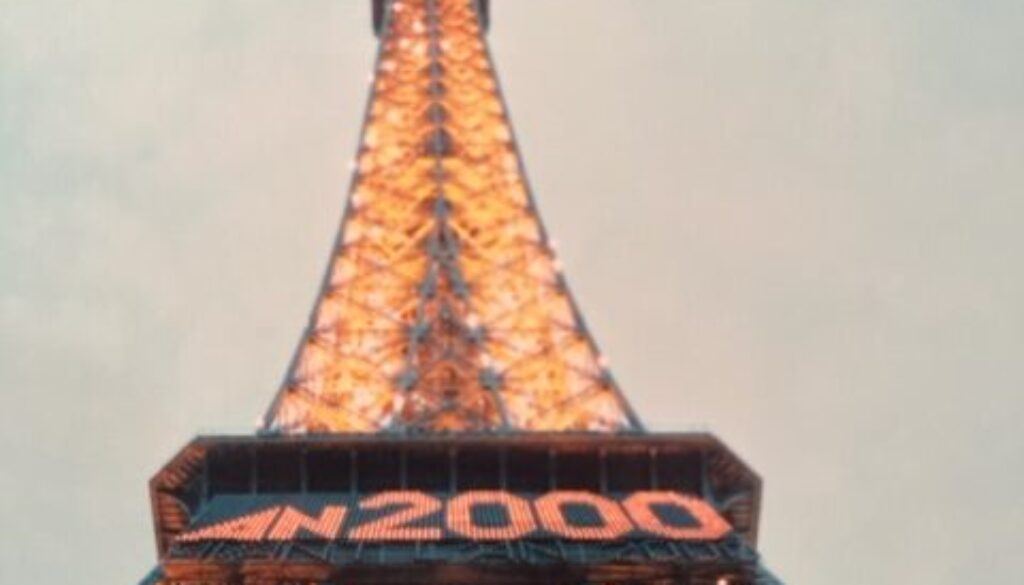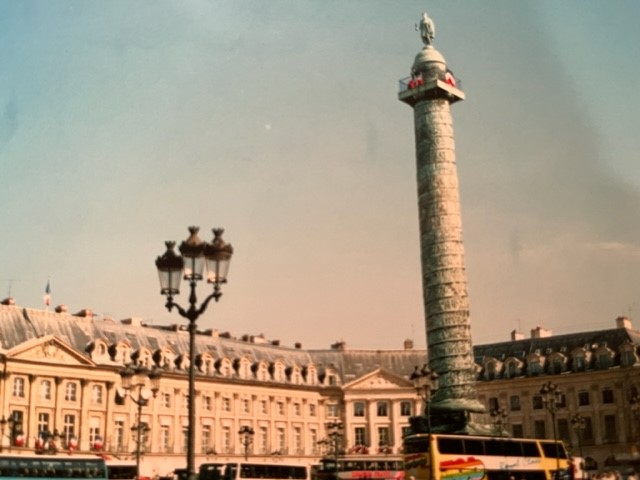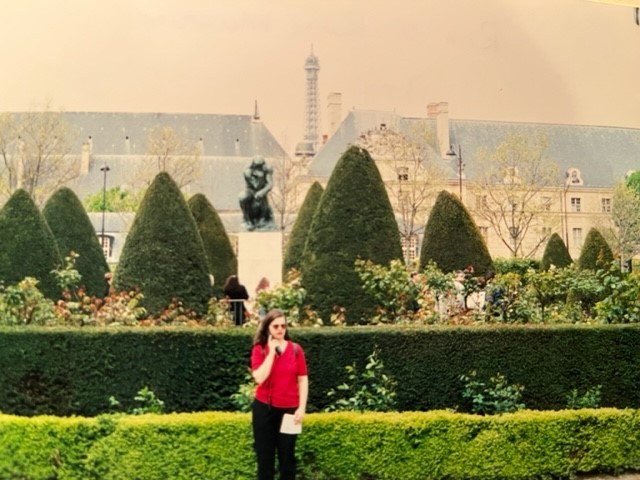An Endless Feast

As we did a couple days ago, we delve the archives, and recall a wonderful place in a pleasant time. [Earlier installments in this series: Orléans, Chenonceau, Amboise, Chambord, Montrichard, Blois, Tours, Chartres, Paris]
Paris, France
April 26, 2000
After the Religious Wars, the Bourbons supplanted the Valois, and moved regal soirées from the Loire to the Seine. For several days, we’ve decided to join them.
The Huguenot Henri Quatre, first of the line, traded religious conviction for royal prerogative, and decided Paris was worth a Mass. He converted to Catholicism, and received the crown. In 1610, the regicide François Ravaillac inflicted Last Rites from the tip of his blade, and power passed to the Regency.
As nobles built elegant châteaux within the Île de France, Henri enhanced his kingdom by beautifying the capital. He bequeathed to Paris the Place Royale, the oldest planned square in the city. It was renamed after the Revolution, and now anchors Le Marais as the Places des Vosges.
Today, that was our destination. From the hotel, we’d need an hour to walk to Le Marais. We decided to take several hours, and sample sights as we made our way. The first were to our south. Or so we thought.
From the Place de la Concorde, we’d cross Le Pont de la Concorde onto the Left Bank, and into the Seventh Arrondissement. A few blocks in, we’d find ourselves at the mansion and gardens housing the works of Rodin.
From there, we could make our way east…thru le Quartier Latin, across le Pont Henri IV toward the Bastille and then, to Le Marias. We’d duck into a café pour déjeuner along the way, and have plenty of time to wander round le Place des Vosges.
But we quickly learned the problem with (and necessity of) planning in Paris. Wherever you walk, and any direction you look, there’s a tempting distraction. Were you to succumb to them all, you’d never get where you intend to go.
After we left the hotel, it took about ten minutes for us to learn that lesson. When we reached Rue Royale, I glanced north, and was quickly captivated by the impressive colonnade of L’Église de la Madeleine. I had to have a look, and Rita was more than willing to indulge my desire.
As we approached this Catholic Church disguised as a classic temple, the elegant entablature came into view, as did the phenomenal Last Judgment with which the impressive pediment is intricately sculpted.
Corinthian columns surround the structure. Reliefs represent the Ten Commandments on the bronze doors. Inside, three domes crown the nave. It’s sublime, and magnificent.
Construction on what eventually became a church started and stopped several times after it was initially conceived in the 18th century. It was initially to be a church modeled on Mansart’s design of Les Invalides. The Revolution halted construction; what had been erected was completely razed.
Napoleon decided the new building should honor his army. But when the emperor was exiled, the restored Bourbons reincarnated the idea of a Catholic church. It was modeled on (and magnified) the Maison Carrée in Nîmes, and was finally consecrated and dedicated to St Mary Magdalene in 1842.
From the top of the steps, a magnificent view captures le Place de la Concorde and the Egyptian obelisk by which it is anchored, with the Palais Bourbon and Hôtel des Invalides across the Seine. That is where we were going next.
Except we didn’t. Within eyeshot of La Madeleine was the Opéra and Place Vendôme. We took the bait, and another detour, moving further from where we’d planned to go.
But who cares? Paris is not only a moveable feast; it’s an unending one. And he who partakes gets hungrier as he eats. With only five days to enjoy the buffet, we can’t consume everything. But we’ll taste whatever this marvelous place puts on our plate.
When the Opéra was offered, we had to take a bite. Just a few blocks from La Madeleine, the Palais Garnier is perhaps the greatest ornament of the Second Empire. The building faces the Place de l’Opéra from which Haussmann radiated a half-dozen roads now lined with opulent shops and refined cafés.
The Magic Flute is playing this week, but I wasn’t proactive enough to purchase tickets. Unable to go inside, we admired the exterior, from which the Austerlitz column called us to Place Vendôme.
To get there, we wandered Le Rue de la Paix, perhaps the most expensive path on the planet. We strolled quickly and pointlessly past an unending array of luxury jewelers, goldsmiths, and shops…and into an elegant plaza of exquisite architecture orbiting a column hoisting a revolving cast of Gallic Caesars.

After a fleeting foray into the Ritz, we wandered the plaza, then picked up the pace. We returned to Place de la Concorde, crossed le Pont de la Concorde, and proceeded past le Palais Bourbon to le Musée Rodin…the first place we’d initially planned to go.
On our way, the Basilique Sainte Clothilde beckoned. But I resisted the urge, and followed my wife. As always, I’m glad I did.
The Rodin museum was marvelous. We often visited the world’s second largest Rodin collection when we lived in Philadelphia. It was a pleasure today to see the first.
The residential setting accentuates the beauty and emotion of the art. The Cathedral, The Kiss, and The Man with a Broken Nose greet the guest who enters the ground floor. Eve and The Age of Bronze anchor each end of the gallery. The rotunda of another room is devoted to drawings, while the top of the staircase features statues of Balzac and Hugo.

But the outdoor garden offered the greatest appeal, with The Thinker, The Burghers of Calais, The Gates of Hell, and The Ugolin Group adorning the grounds. Next door, and looming over all of them, was our next stop.
During the 1900 World Exposition, Czar Nicholas II laid the foundation stone of the bridge named for his father. Le Pont Alexandre III evokes the popular ornate steel style of Le Belle Epoque, and affords a fine view across the Esplanade of Les Invalides.
Paris abounds in elegant edifices. But few are as impressive and outstanding than the one housing the tomb of France’s infamous emperor. Before the reign of Louis XIV, the lucky invalid soldiers were relegated to convent hospitals. But most were relegated to the streets.
In 1670, the Sun King intended to rectify this by establishing Les Invalides outside of town on the edge of a plain. Four decades later, the utilitarian structure became monumental with the addition of the dome designed by Jules Mansart.
We entered thru a garden promenade toward, as our guidebook put it, “an equestrian statue of the Sun King supported by Prudence and Justice in the rounded arch above the entrance.” The entire complex, from the Musée de l’Armée, l’Église de St-Louis, and l’Église du Dôme is magnificent.
The cupola covers Napoleon’s tomb, producing an effect endowed with graceful dignity. Forty columns support a balustrade encircling the base of the dome. Pilasters frame arched windows between the consoles. The elaborately ornamented dome is capped with an elegant gold lantern, and a spire supported by the Four Virtues of Faith, Hope, Charity, and Religion. The gold gilding was applied in 1715, and refurbished in 1989 for the bicentennial of the fall of the Bastille.
The interior is sumptuous, a setting perfectly befitting an emperor’s tomb. The cupola covers Napoleon’s body, which is wrapped in a Matryoshka of six coffins of different material. That’s too bad for him, because he is unable to enjoy the splendor by which he is surrounded. Paintings, columns, and pilasters frame low-relief sculptures grace this arresting room.
We continued to Musée de l’Armée and l’Église de St-Louis, and realized that…as with so many courses in the Parisian meal…we could spend much of the day sampling the one we’re currently served. To avoid being overwhelmed, we had to move on from Les Invalides.
As the afternoon progressed, we knew our original plans were destined for another day. But that was fine. We decided to take this marvelous city as it came. We strolled east up Rue de Grenelle, past Rita’s aunt’s Musée Maillol, and then over to Boulevard Saint-Germain for an obligatory drink at Les Deux Magots.
Having taken a few moments to watch the passing scene as we wet our beak and rested our feet, we hopped back on them, and resumed our walk. After a brief peak into Saint-Sulpice, we opted for more open air…which we found at the Luxembourg Gardens.
After the assassination of Henri IV, his widow Marie de Médicis began building the Palais du Luxembourg. She nestled into it as construction continued, and ruled France as regent for the young Louis XIII. He was not yet nine when his dad died, and would be the first of three consecutive child-kings to ascend the French throne.
Marie de Médicis modeled her new palace on the Palazzo Pitti in her native Florence. As it rose, she requested an equestrian statue of her dead husband. It was completed a few years later, but was toppled during the Revolution.

After the Restoration, the last Bourbon kings paid homage to the first. Henri’s statue was replaced in 1818, and still graces L’île de la Cité toward the middle of the Pont Neuf. We went there next.
The oldest bridge to span the Seine is a thing of beauty. Henri III, the last Valois king, decided to build it only forty years before a statue of the first Bourbon king was placed upon it. He placed the first stone in 1578. Construction was completed thirty years later.
Benjamin Franklin once wrote that he’d not understood the Parisian character till he’d crossed the Pont Neuf. Having done so ourselves, I can see what he meant.
The bridge is an orderly concatenation of several elliptical arched structures: seven connecting L’île de la Cité to the Right Bank of the Seine; five communicating with the Left.
But it’s also slightly askew, a design decision intended to alleviate the impact of corrosive currents. It’s been considered the center of Paris, a focal point, and a meeting spot. Merchants bargained atop it, gangs lurked beneath it, and shysters used it as a base from which to pick the pockets of passing prey.
It was relatively uncrowded when we crossed. That’s probably because it’s undergoing restoration. Like a dark veil over the face of a beautiful woman, scaffolding shielded portions of le pont. But enough of it was visible for us to see it smile.
By the mid-seventeenth century, architectural change was in the Parisian air. The city learned from the 1667 fire of London to replace timber and plaster with brick and stone. By the time the reign of Le Roi Soleil ended, much of Paris would be made of marble.
But Louis’s attention lay west of town, where from isolated swamps rose the castle that would house the great king of le grande siècle.
We’ll go there tomorrow, taking a break from Paris after barely beginning its buffet today.
JD



